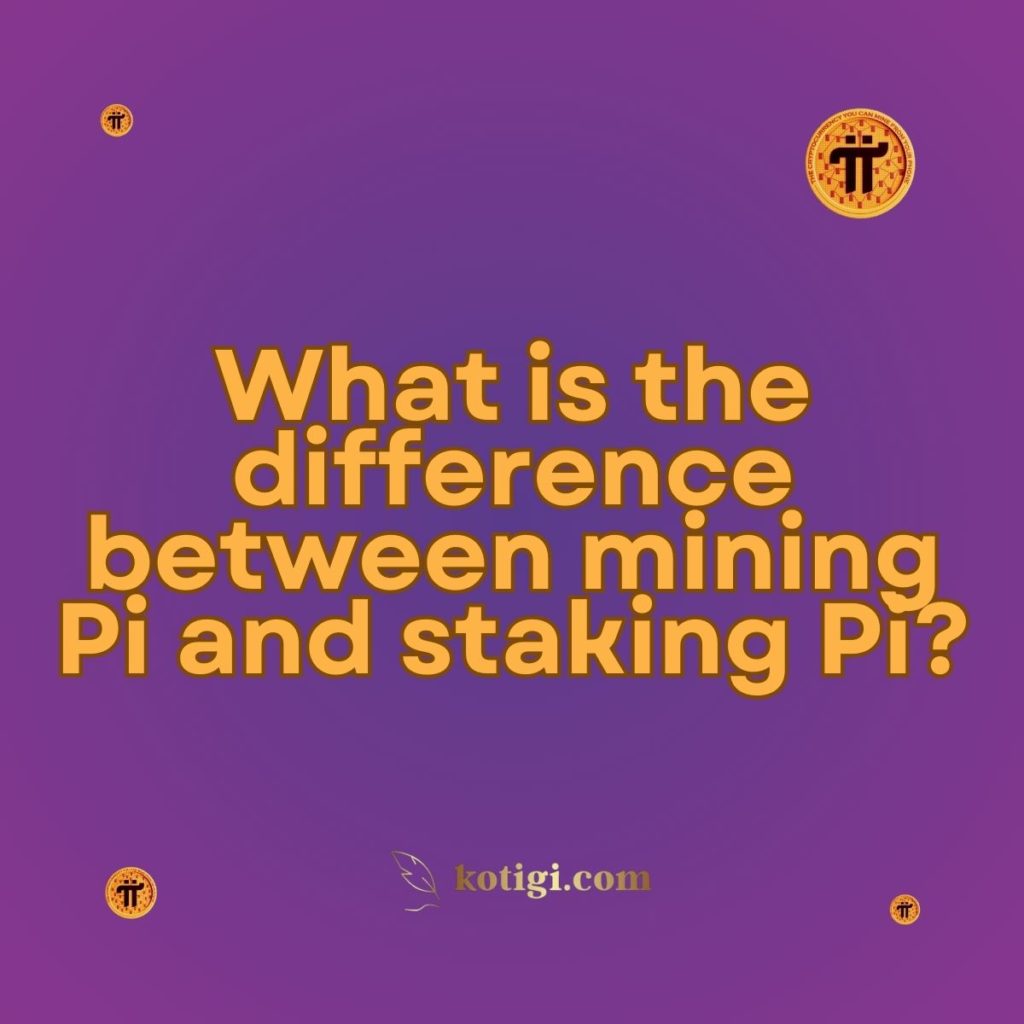
What is the difference between mining Pi and staking Pi?
Mining Pi involves earning Pi tokens through daily engagement and participation in the network, while staking Pi refers to locking up Pi tokens to support network operations and earn rewards. Understanding these differences is crucial for maximizing your benefits within the Pi Network ecosystem.
Introduction
As the cryptocurrency landscape evolves, new concepts and mechanisms have emerged to facilitate token acquisition and support network security. Pi Network, with its innovative approach to mining and staking, offers users various ways to engage with the platform and benefit from its ecosystem. Mining Pi allows users to earn tokens through daily interactions, while staking Pi involves locking up tokens to support the network’s operations and earn additional rewards. This blog post explores the fundamental differences between mining Pi and staking Pi, highlighting their respective processes, rewards, requirements, and impacts on the Pi Network ecosystem.
Comparison table Mining Pi Vs Staking Pi
Here’s a comparison table outlining the differences between mining Pi and staking Pi:
| Feature | Mining Pi | Staking Pi |
|---|---|---|
| Definition | Earning Pi tokens through daily app engagement | Locking Pi tokens to support network operations |
| Process | Tap the mining button daily | Lock tokens for a specified duration |
| Accessibility | Open to anyone with a smartphone | Requires ownership of Pi tokens |
| Energy Consumption | Minimal, designed to be energy-efficient | None, as it involves holding tokens |
| Rewards | Earn tokens based on participation and security circle | Earn rewards from locked tokens and network fees |
| User Engagement | Requires daily engagement with the app | Requires understanding staking mechanics and lock-up |
| Community Impact | Fosters community through security circles | Represents commitment to the network |
| Security Contribution | Enhances network security through transaction validation | Supports network security by locking tokens |
| Governance Role | Limited governance involvement | May include voting rights on network decisions |
| Future Developments | Expected to evolve with mainnet transition | Anticipated enhancements as the network matures |
This table summarizes the key differences between mining and staking within the Pi Network, making it easier for users to understand their options.
1. Understanding Mining Pi
1.1 What is Mining?
Mining is a foundational process in the world of cryptocurrencies, involving the validation of transactions and the addition of new blocks to a blockchain. In the case of Pi Network, mining has been designed to be user-friendly and highly accessible, leveraging the capabilities of mobile devices. Users engage in mining by simply using the Pi Network application, where they can earn Pi tokens by interacting with the app daily. This innovative approach allows individuals who may not have access to expensive hardware or technical knowledge to participate in the cryptocurrency space.
1.2 How Pi Mining Works
Users mine Pi by pressing a button in the app once every 24 hours. This straightforward action does not require complex hardware or substantial energy consumption, making it an inclusive process for anyone with a smartphone. Unlike traditional mining, which often requires vast computational power and electricity, Pi mining operates on a more efficient model. The network employs a unique algorithm that enables users to contribute to the ecosystem simply by engaging with the application, thereby democratizing access to cryptocurrency mining.
1.3 Rewards for Mining
The rewards for mining Pi are determined by several factors, including the user’s Base Mining Rate (BMR), their participation in security circles, and the overall growth of the network. The BMR can be influenced by how actively users engage with the app and how many trusted individuals they invite to join their security circle. As the network expands and more users participate, the mining rate adjusts to control the supply of Pi tokens, ensuring a balance between token availability and value. This dynamic reward structure incentivizes continuous user engagement and community building.
2. Understanding Staking Pi
2.1 What is Staking?
Staking is another essential concept in the cryptocurrency ecosystem that involves locking up a certain amount of cryptocurrency to participate in network operations. This process helps secure the network and validate transactions, providing a decentralized approach to governance and operations. In Pi Network, while staking is still in development, it is anticipated to allow users to lock their Pi tokens to support network functionality and earn rewards over time. This mechanism aligns user incentives with the health and security of the network.
2.2 How Staking Works in Pi Network
The staking process in Pi Network will likely involve users locking their Pi tokens for a specified duration. This locked amount could help validate transactions and maintain the integrity of the network. The specifics of staking—such as lock-up periods and the exact mechanics of reward distribution—are still being refined as Pi Network evolves. Users who stake their tokens may receive rewards in the form of additional tokens or a share of network fees, which encourages long-term commitment to the network.
2.3 Rewards for Staking
Rewards for staking typically arise from network fees, inflation, or newly minted tokens. As Pi Network continues to develop its governance and economic model, the specific mechanics of how staking rewards will be allocated are expected to be clarified. Staking can create a more stable and engaged user base, as individuals who lock up their tokens have a vested interest in the network’s success. This approach not only incentivizes holding but also supports the overall security and functionality of the Pi ecosystem.
3. Key Differences Between Mining and Staking
3.1 Process of Earning Tokens
The primary distinction between mining and staking lies in the process of earning tokens. Mining allows users to earn tokens through daily engagement with the app, while staking requires users to lock their tokens for a designated period. This difference in process reflects the varying levels of commitment and interaction with the network that each method demands. While mining is highly accessible and straightforward, staking necessitates a more deliberate investment of resources and time.
3.2 Accessibility
In terms of accessibility, mining is open to anyone with a smartphone, requiring minimal effort and technical knowledge. Users can easily participate by downloading the app and engaging with it daily. In contrast, staking requires users to own and lock a certain amount of Pi tokens, which may limit participation to those who have accumulated a sufficient quantity of tokens. This aspect of staking can create barriers for newcomers who may not yet have the resources to engage fully in the network.
3.3 Energy Consumption
Energy consumption is another critical factor that differentiates mining and staking. Mining in Pi Network is designed to be energy-efficient, with users able to mine without the need for intensive computational power. Traditional mining processes, such as those seen in Bitcoin, consume significant amounts of electricity, leading to environmental concerns. Staking, on the other hand, typically does not require additional energy since it involves holding tokens rather than active computations. This distinction highlights Pi Network’s commitment to sustainability and accessibility.
4. Requirements for Mining Pi
4.1 Minimal Equipment
To mine Pi, users need only a smartphone and the Pi Network app. This minimal requirement makes it easy for anyone to participate, regardless of technical expertise or resources. Unlike traditional mining, which often requires expensive hardware and a significant initial investment, Pi mining democratizes access to cryptocurrency earning opportunities. This inclusive approach enables a diverse range of users to join the Pi community, fostering greater participation and network growth.
4.2 Daily Engagement
A critical requirement for mining Pi is consistent daily engagement. Users must interact with the app regularly by pressing the mining button to maximize their rewards. This daily commitment not only helps users accumulate tokens but also enhances the overall activity within the network. The emphasis on regular participation creates a dynamic environment where users are incentivized to remain engaged and connected with the community.
4.3 Security Circle Participation
Building a trusted security circle is essential for enhancing mining rewards. Users can invite friends and trusted contacts to join their security circle, which increases their mining capacity. The more trusted individuals a user invites, the greater their potential rewards become. This focus on social connections promotes a sense of community and trust, reinforcing the collaborative nature of the Pi Network.
5. Requirements for Staking Pi
5.1 Holding Pi Tokens
To stake Pi, users must possess a certain number of Pi tokens that they are willing to lock up for a specified period. This requirement means that users need to have an understanding of the token’s current value and the potential implications of staking their assets. By holding and staking tokens, users can contribute to the network’s security while earning rewards, making it a strategic decision that requires careful consideration.
5.2 Understanding Staking Mechanics
Users who wish to participate in staking must familiarize themselves with the mechanics of the process, including potential lock-up periods and the criteria for earning rewards. This understanding is crucial for making informed decisions about when and how much to stake. As the staking feature develops within Pi Network, user education will play a significant role in ensuring that participants are aware of the benefits and risks associated with staking.
5.3 Participation in Governance
Staking may also involve participating in governance decisions within the network. As users lock their tokens, they may gain voting rights or the ability to influence key decisions regarding the network’s direction and policies. This participatory aspect of staking fosters a sense of ownership among users, encouraging them to engage actively in the governance of the Pi ecosystem.
6. Impact on Network Security
6.1 Mining and Security
Mining plays a vital role in enhancing network security by engaging users in the validation of transactions. The collective participation of miners not only helps maintain the integrity of the blockchain but also builds trust among users. By ensuring that transactions are verified by multiple participants, Pi Network can operate in a decentralized manner, mitigating the risks associated with centralization and enhancing the overall resilience of the network.
6.2 Staking and Security
Staking adds an additional layer of security to the network as users lock their tokens, creating an incentive to act honestly and support the network’s integrity. The commitment that comes with staking ensures that participants have a vested interest in the network’s success, further reinforcing its security. By locking tokens, users contribute to the validation process, enhancing the decentralized nature of the network and reducing the likelihood of malicious activities.
6.3 Decentralization
Both mining and staking promote decentralization by distributing power and control among users. This decentralized structure is a fundamental principle of blockchain technology, ensuring that no single entity has overwhelming control over the network. By enabling a broad user base to engage in both mining and staking, Pi Network seeks to create a more equitable and resilient ecosystem that reflects the core values of decentralization.
7. Economic Model of Pi Network
7.1 Supply Control through Mining
The mining process is integral to controlling the supply of Pi tokens. By adjusting the mining rate based on user growth, the network can manage the availability of tokens, helping to maintain their value over time. This supply control mechanism is essential for ensuring that the token remains a viable medium of exchange and store of value as the network matures.
7.2 Inflation and Staking Rewards
Staking can introduce inflation into the network, as new tokens may be issued as rewards for those who lock up their assets. This potential for inflation underscores the importance of understanding the economic implications of staking. Participants should be aware of how their actions may influence the overall token economy, including factors such as supply, demand, and value stability.
7.3 Balancing Both Mechanisms
Pi Network aims to strike a balance between mining and staking to ensure that both processes contribute to the network’s security and sustainability. By integrating these two mechanisms effectively, the network can create a robust economic model that supports growth and user engagement. This balance is crucial for fostering a thriving ecosystem that benefits all participants.
8. Community Engagement
8.1 Mining as a Community Builder
Mining encourages community building by requiring users to invite friends and form security circles. This social aspect fosters trust and collaboration within the network. As users engage with their contacts, they not only enhance their mining capabilities but also strengthen the overall community, creating a sense of belonging and shared purpose.
8.2 Staking as a Commitment
Staking represents a commitment to the network, as users lock up their tokens and potentially engage in governance. This commitment can deepen community ties and shared goals, encouraging users to work together towards common objectives. By participating in staking, users demonstrate their dedication to the network’s success, reinforcing the community’s collaborative spirit.
8.3 User Education
Both mining and staking require user education to ensure participants understand the processes, rewards, and risks involved. The Pi Network community can benefit from educational resources, tutorials, and discussions that enhance users’ knowledge and capabilities. By fostering a well-informed user base, Pi Network can build a stronger and more engaged community that is equipped to navigate the complexities of the cryptocurrency landscape.
9. Future Developments
9.1 Transition to Mainnet
As Pi Network transitions to its mainnet, both mining and staking mechanisms may evolve. Users should stay informed about upcoming changes that could impact their participation and rewards. The transition to a fully operational mainnet will introduce new features, functionalities, and governance structures, making it essential for users to adapt to the changing landscape.
9.2 Enhancements in Staking
Future updates may introduce more features and opportunities for staking, including governance roles and enhanced reward structures. As the network matures, participants can expect improvements that make staking more attractive and rewarding. Staying informed about these enhancements will allow users to maximize their involvement and benefits within the ecosystem.
9.3 The Role of Community Feedback
The Pi Network team may rely on community feedback to refine and improve both mining and staking processes. User insights and suggestions can play a crucial role in shaping the future of the network, ensuring that it meets the needs and expectations of its participants. This collaborative approach emphasizes the importance of community involvement in the ongoing development of Pi Network.
Conclusion
The differences between mining Pi and staking Pi reflect the innovative and user-centric approach of Pi Network. While mining is accessible and requires minimal effort, staking involves a more committed approach to supporting network operations. As Pi Network continues to develop, understanding these differences will be crucial for users looking to maximize their engagement and rewards within the ecosystem. By actively participating in both processes, users can contribute to the network’s growth and sustainability, positioning themselves for success in the evolving cryptocurrency landscape.
Key Takeaways
| Key Factors | Description |
|---|---|
| Mining Process | Involves daily engagement with the app to earn Pi tokens. |
| Staking Process | Involves locking up Pi tokens to earn rewards and support network operations. |
| Accessibility | Mining is open to anyone with a smartphone; staking requires owning and locking tokens. |
| Energy Consumption | Mining is energy-efficient; staking typically requires no additional energy. |
| Rewards Structure | Mining rewards vary with engagement; staking rewards depend on locked tokens and network fees. |
| Community Building | Mining fosters community through security circles; staking represents commitment to the network. |
| Security Contributions | Both mining and staking enhance network security but through different mechanisms. |
| Future Developments | Both processes are expected to evolve with the transition to the mainnet, enhancing user experience. |
| Economic Impact | Mining controls token supply; staking can introduce inflation based on rewards. |
| User Education | Both processes require understanding of the mechanisms, rewards, and risks involved. |





